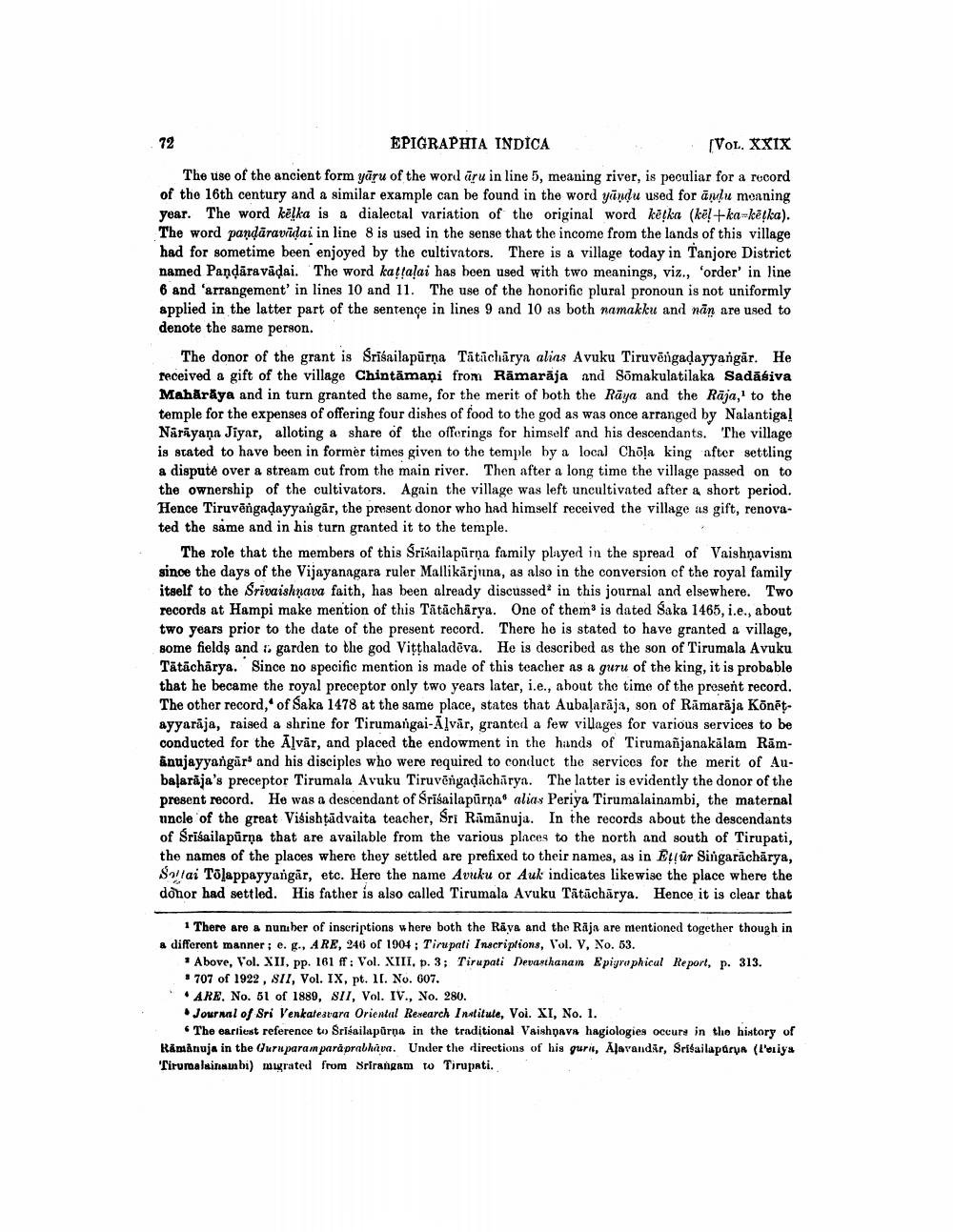________________
EPIGRAPHIA INDICA
(VOL. XXIX The use of the ancient form yūru of the word āru in line 5, meaning river, is peculiar for a record of the 16th century and a similar example can be found in the word yandu used for anu meaning year. The word këlka is a dialectal variation of the original word kēļka (kēļ+ka-kēka). The word pandaravridai in line 8 is used in the sense that the income from the lands of this village had for sometime been enjoyed by the cultivators. There is a village today in Tanjore District named Pandāravādai. The word kattalai has been used with two meanings, viz., 'order' in line 6 and 'arrangement' in lines 10 and 11. The use of the honorific plural pronoun is not uniformly applied in the latter part of the sentence in lines 9 and 10 as both namakku and nän are used to denote the same person.
The donor of the grant is Srisailapūrņa Tātachārya alias Avuku Tiruvöngadayyangār. He received a gift of the village Chintāmani from Rāmarāja and Somakulatilaka Sadāśiva Mahārāya and in turn granted the same, for the merit of both the Rāya and the Raja, to the temple for the expenses of offering four dishes of food to the god as was once arranged by Nalantiga! Nārāyana Jiyar, alloting a share of the offerings for himself and his descendants. The village is stated to have been in former times given to the temple by a local Chola king after settling a dispute over a stream cut from the main river. Then after a long time the village passed on to the ownership of the cultivators. Again the village was left uncultivated after a short period. Hence Tiruvēngadayyangār, the present donor who had himself received the village as gift, renovated the same and in his turn granted it to the temple.
The role that the members of this Srisailapūrņa family played in the spread of Vaishņavism since the days of the Vijayanagara ruler Mallikärjuna, as also in the conversion of the royal family itself to the Srivaishnava faith, has been already discussed in this journal and elsewhere. Two records at Hampi make mention of this Tātāchārya. One of them is dated Saka 1465, i.e., about two years prior to the date of the present record. There he is stated to have granted a village, some fields and garden to the god Vitthaladēva. He is described as the son of Tirumala Avuku Tātācharya. Since no specific mention is made of this teacher as a guru of the king, it is probable that he became the royal preceptor only two years later, i.e., about the time of the present record. The other record, of Saka 1478 at the same place, states that Aubalaraja, son of Ramarāja Konēt. ayyarāja, raised a shrine for Tirumangai-Alvār, granted a few villages for various services to be conducted for the Alvär, and placed the endowment in the hands of Tirumañjanakālam Rāmanujayyangūrs and his disciples who were required to conduct the services for the merit of Aubalaraja's preceptor Tirumala Avuku Tiruvēngadācharya. The latter is evidently the donor of the present record. He was a descendant of Srisailapūrņa alias Periya Tirumalainambi, the maternal uncle of the great Visishtādvaita teacher, Sri Ramānuja. In the records about the descendants of Srisailapürna that are available from the various places to the north and south of Tirupati, the names of the places where they settled are prefixed to their names, as in Ellur Singarachārya, Sallai Tolappayyangār, etc. Here the name Avuku or Auk indicates likewise the place where the donor had settled. His father is also called Tirumala Avuku Tätächārya. Hence it is clear that
1 There are a nun,ber of inscriptions where both the Räya and the Raja are mentioned together though in a different manner; e. g., ARE, 246 of 1904 ; Tirupati Inscriptions, Vol. V, No. 53.
* Above, Vol. XII, pp. 161 ff: Vol. XIII, p. 3; Tirupati Devasthanam Epigraphical Report, p. 313. * 707 of 1922, SII, Vol. IX, pt. 11. No. 607. ARE. No. 51 of 1889, SII, Vol. IV., No. 280. Journal of Sri Venkatesvara Oriental Research Institute, Voi. XI, No. 1.
The earliest reference to Srisailapürna in the traditional Vaishnava hagiologies occurs in the history of Rånånuja in the Guruparam paraprabhava. Under the directions of his gurit, Alavandăr, Srisailapúrys (L'eliya Tirumalainabi) migrated from Srirangam to Tirupati.




